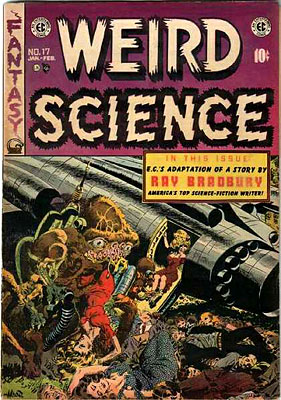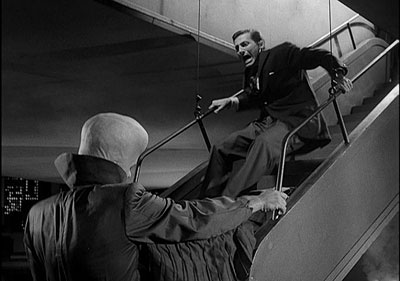Aliens Ate My Neighbor
By Bert Ehrmann
November 5, 2010
 I've always loved the science fiction notion of intelligent aliens that come to the Earth to, simply put, eat people. It's a bizarre notion that an alien species would a) have some sort of culture of their own that's been around for thousands of years, b) develop space travel that allows them to roam (at the very least) the galaxy and c) also just happen to have a taste for man-flesh. Regardless of how preposterous this idea may be it's been turning up in sci-fi stories for the last 50+ years.
I've always loved the science fiction notion of intelligent aliens that come to the Earth to, simply put, eat people. It's a bizarre notion that an alien species would a) have some sort of culture of their own that's been around for thousands of years, b) develop space travel that allows them to roam (at the very least) the galaxy and c) also just happen to have a taste for man-flesh. Regardless of how preposterous this idea may be it's been turning up in sci-fi stories for the last 50+ years.
Two of the earliest stories I could find that deals with man-eating aliens were from 1952 in the Weird Science comic book entitled "Plucked!" and "Bum Steer!" In "Plucked!" aliens come to the Earth every 200 years to harvest a new crop of people and in "Bum Steer!" a group of men find themselves as cattle aboard an alien ship.
The two most well known of these types of aliens eating people stories is The Twilight Zone episode from 1962 "To Serve Man" and the 1983 TV miniseries/series V.
 In "To Serve Man" the aliens species the "Kanamits" come to Earth and in short order use their advanced technology to end hunger, disease and warfare. The Kanamits are so cool they even carry around these books about how they can best help people that's entitled "To Serve Man." However, after a group of scientists gets a hold of the book and decodes the alien language to our own they discover that it's not a book about helping people, it's a cookbook on the best ways to serve man at what I am assuming is Kanamit Thanksgiving. This story was based on a 1950 short-story of the same name that's probably the first example of these types of stories.
In "To Serve Man" the aliens species the "Kanamits" come to Earth and in short order use their advanced technology to end hunger, disease and warfare. The Kanamits are so cool they even carry around these books about how they can best help people that's entitled "To Serve Man." However, after a group of scientists gets a hold of the book and decodes the alien language to our own they discover that it's not a book about helping people, it's a cookbook on the best ways to serve man at what I am assuming is Kanamit Thanksgiving. This story was based on a 1950 short-story of the same name that's probably the first example of these types of stories.
 The series V dealt with essentially the same plot as "To Serve Man." Here, the alien "Visitors" come to Earth and promise to help advance our technology and in return only want some common Earth elements we'll hardly miss. Except it turns out the Visitors are really lizards in disguise who are really after our water and to put as many people as they can in gigantic freezers on their ships for later consumption.
The series V dealt with essentially the same plot as "To Serve Man." Here, the alien "Visitors" come to Earth and promise to help advance our technology and in return only want some common Earth elements we'll hardly miss. Except it turns out the Visitors are really lizards in disguise who are really after our water and to put as many people as they can in gigantic freezers on their ships for later consumption.
I'd argue the best of these types of stories was the UK mini-series The Quatermass Conclusion. In this show, Professor Bernard Quatermass finds himself fighting aliens who lure large groups of young people together and instead of delivering the promised peace and free-love zap them into deep space and presumably onto some alien dinner table.
Things have gotten so bad that the sky literally turns green from the effects of so many people being fried alive when they're taken by the aliens. It's only when Quatermass gets together a group of aged scientists, because presumably the younger ones have already been served on some smorgasbord, and send an h-bomb along with the next group of people that the aliens get the message and go looking for dinner elsewhere.
Surprisingly, this concept still turns up in modern times as well. M. Night Shyamalan's Signs (2002) dealt with aliens who, in the end, have come to Earth looking for people to take home and munch on and the upcoming movie Skyline, due out 11/12, seems to also deal with the same subject.
In the trailer for Skyline, gigantic ships begin appearing over major cities and emit weird beams of light that suck "things" up from the cities and into the ships. Upon closer examination, these "things" being sucked up into the ships turns out to be screaming people. Yikes!
The funniest of these types of stories I was able to find was called "Emergency Rations" and appeared in the comic Alien Encounters in 1985. Here, an alien ship is damaged by a meteor storm and the crew within find themselves lucky to stumble across a "Human Emergency Rescue Station." These aliens know of the humans only from their rescue stations and think of us as an, "Ancient and benevolent race (who) thousands of years ago scattered emergency rescue stations throughout the galaxy." The two catches are that no alien has ever met a human and the emergency rations stored aboard these stations are "monotonous."
It turns out, though, that these rescue stations aren't really rescue stations and are instead human colony ships on long-range missions away from the Earth. And those "emergency rations?" They turn out to be colonists in hybernetic sleep. Ick!